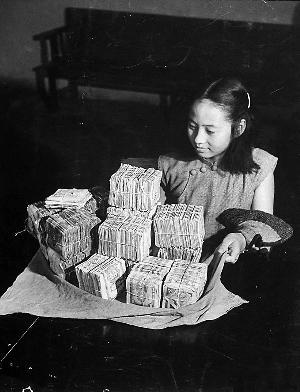Why and How the CPC Works in China
 0 Comment(s)
0 Comment(s) Print
Print E-mail
China.org.cn, June 30, 2011
E-mail
China.org.cn, June 30, 2011
Stabilization of prices and unification of finance and economy
The first challenge for the CPC was to rein in soaring prices. On the eve of the founding of New China – in January, April, and July, 1949 – there were three large fluctuations of prices. The successive waves of rising prices seriously affected people's lives, and brought instability to the entire community. If inflation was not curbed, not only the restoration of the national economy, but also the very existence of the new government would be out of the question.
The key to stabilizing prices was to hold down prices in Shanghai and several other major cities. After Shanghai was liberated on May 27, 1949, financial speculators forced up the price of silver dollars. The black market price of a silver dollar rose from 600 yuan to 1,800 yuan. This fuelled a wave of price rises across the board. On June 10 the Military Control Commission of Shanghai closed the Shanghai Securities Building, struck a heavy blow at the illegal activities which were destroying the country's finances, brought down the silver dollar price and enabled the Renminbi to circulate in the market relatively smoothly.
However, the speculators soon turned their attention to the grain, cotton yarn and coal markets, which triggered another violent wave of nationwide price rises. In less than three months from the end of July to mid-October, the average price index of Shanghai rose by 1.5 times, and those of Beijing, Tianjin and other cities by 1.8 times. To battle rising prices, hoarding and speculating, the CPC Central Committee and the Central People's Government transferred large batches of grain, cotton yarn and coal from all over the country to Shanghai, Beijing, Tianjin and other major cities.
On November 25, the day when prices spiked, the major cities worked together to sell goods in short supply, to bring down prices, and tightened the money supply and levied taxes. As a result, speculators suffered a failure in cash flow and depreciation in their hoarded supplies. By December 10 the "Fight for Food and Cotton" had achieved a decisive victory. This was a success achieved by the proper use of the law of commodities to control the complex and volatile market, and convinced the patriotic national bourgeoisie to throw its weight behind the leadership of the CPC and the Central People's Government.
The socialist state-operated economy gained the initiative in stabilizing the market, and created the conditions for making efforts to achieve a basic improvement in the financial and economic situation of the country. However, with the monthly increase in military and administrative expenses, and increasing fiscal deficits, price volatility was still inevitable. In order to stabilize prices, a national fiscal balance and a balance of market supply and demand had to be achieved. However, because the war with the KMT army was still going on, the financial work of the original liberated areas had not changed. Grain and various other taxes levied by local governments were mainly used for local expenses, and there were no specific rules and regulations for turning them over to the higher authorities.
The central government bore the costs of the war (When New China was founded, the whole country was not yet liberated), administrative expenses and other large expenses, but it did not have a sufficient and stable income. If the revenue was not centralized within the central government, but continued to be controlled by local governments, and the central government simply printed more banknotes, there would not be a stable foundation for the recovery and development of the national economy. Thereupon, the CPC decided on a major move to unify national financial work under the central government to achieve uniform plans and strict enforcement of orders and prohibitions.
By April 1950 the national revenue and expenditure were basically balanced. Hyperinflation and soaring prices, which had afflicted the people for a long time and which the KMT government was unable to put an end to, finally became things of the past. Taking the wholesale price index in March 1950 as 100, it declined to 85 in December the same year. It was 92.4 in December 1951, and 92.6 in December 1952. Within less than a year market prices were stabilized. Having suffered from inflation, economic contraction and social upheaval for decades, the Chinese people were relieved to live a stable life at last, and their trust and support for the people's government led by the CPC were greatly enhanced. The total deposits of the People's Bank of China in September 1950 were more than 12 times those of December 1949. Economic stability was greatly beneficial to social stability, and vice versa. Mao Zedong spoke highly of the significance of the stabilization of prices and the unification of the country's finance and economy, saying that this achievement was no less important than the victory of the Huaihai Campaign.





